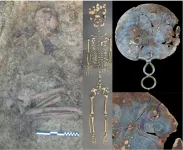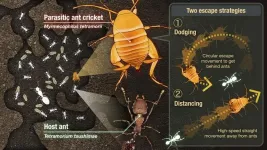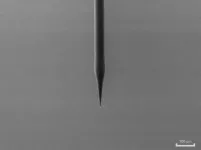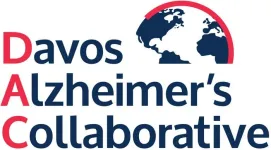(Press-News.org) Proteins are the foundation of all life we currently know. With their virtually limitless diversity, they can perform a broad variety of biological functions, from delivering oxygen to cells and acting as chemical messengers to defending the body against pathogens. Furthermore, most biochemical reactions are only possible thanks to enzymes, a special type of protein catalysts.
The molecular surface of proteins is the key to their function, such as docking small molecules or other proteins or driving chemical reactions. Much like a key fits only one lock and activates it, proteins often interact exclusively with a single molecular structure that precisely matches their surface.
This principle is exploited in drug development: drug molecules are designed to bind to specific proteins, altering their surface and, consequently, their behavior. The newly created "neo-surface" can in turn form novel interactions with other proteins. Molecules designed to bring together different proteins that otherwise would not interact are called “molecular glues,” and are a promising modality to treat diseases by inactivating or degrading proteins that cause disease.
New Proteins with a molecular fingerprint
A long-term collaboration of Michael Bronstein, scientific director of AITHYRA, the new Institute of the Austrian Academy of Sciences (ÖAW), with the team of Bruno Correia at the EPFL Laboratory for Immunoengineering and Protein Design has pioneered the use of geometric deep learning architecture called "Molecular Surface Interaction Fingerprinting" (MaSIF)1 to design new proteins2 with desired molecular surface properties.
In a new study3 published in Nature this week, the team applied MaSIF to proteins with bound drug molecules and showed that it can be used to design proteins that bind to these neo-surfaces.
“One of the key challenges of machine learning approaches is their generalization ability, or how well the method works on data never seen before,” explains Michael Bronstein. “One of the surprising and satisfying outcomes of our study is that a neural network trained on natural interactions between proteins generalizes very well to protein-ligand neo-surfaces never seen before. It seems that geometric descriptors of molecular surfaces extracted by our method are a sort of “universal language” for protein interactions.”
“The new approach allows us to design switchable protein interactions,” Bruno Correia says. “We can create new protein binders that interact with target proteins only in the presence of a small molecule. This opens a new avenue to precise dosing and control of biological drugs such as those used in oncological immunotherapies.”
Experiments validate virtual results
The researchers experimentally validated their novel protein binders against three drug-bound protein complexes containing the hormone progesterone, the FDA-approved leukemia drug Venetoclax, and the naturally occurring antibiotic Actinonin, respectively. The protein binders designed using MaSIF successfully recognized each drug-protein complex with high affinity. The team explains that this was possible because MaSIF is based on general surface features that apply to proteins and small molecules alike, so they were able to map the small molecule features onto the same descriptor space that MaSIF was trained on for proteins.
“MaSIF has a relatively small number of parameters – around 70,000 versus billions for large deep learning systems like ChatGPT,” explains PhD student and co-author Arne Schneuing, “This is possible because we use only key surface features, resulting in a high level of abstraction. In other words, we don’t give the system the full picture; only the part we think matters for solving the problem.”
Co-first author Anthony Marchand is excited about the prospects of the new approach. “Our idea was to engineer an interaction in which a small molecule causes two proteins to come together. Some approaches have focused on screening for such small molecules, but we wanted to design a novel protein that would bind to a defined protein-drug complex.” He believes that “such designed chemically induced protein interactions will have the potential to expand the sensing repertoire and the assembly of new synthetic pathways in engineered cells for innovative drug-controlled cell-based therapies.”
###
Cited Literature:
1: P. Gainza et al., Deciphering interaction fingerprints from protein molecular surfaces using geometric deep learning, Nature Methods (2020)
2: P. Gainza et al., De novo design of protein interactions with learned surface fingerprints, Nature (2023)
3: A. Marchand et al., Targeting protein-ligand neosurfaces with a generalizable deep learning tool, Nature (2024)
Pictures attached:
1 Michael Bronstein landscape © Natascha Unkart
2 Michael-Bronstein portrait © Natascha Unkart
3 Michael Bronstein (left) with Bruno Correia (right) © Charlie Harris
The Study “Targeting protein-ligand neosurfaces using a generalizable deep learning approach” was published in Nature on January 15, 2025. DOI: 10.1038/s41586-024-08435-4 https://www.nature.com/articles/s41586-024-08435-4
Authors: Anthony Marchand, Stephen Buckley, Arne Schneuing, Martin Pacesa, Pablo Gainza, Evgenia Elizarova, Rebecca M. Neeser, Pao-Wan Lee, Luc Reymond, Maddalena Elia, Leo Scheller, Sandrine Georgeon, Joseph Schmidt, Philippe Schwaller, Sebastian J. Maerkl, Michael Bronstein & Bruno E. Correia
Funding: This work was supported the Swiss National Science Foundation, the National Center of Competence in Research in Molecular Systems Engineering, the National Center of Competence in Research in Catalysis , a EPSRC Turing AI World-Leading Research Fellowship, Microsoft Research AI4Science, VantAI, Huawei Technologies Düsseldorf, Reprodivac, the H2020 Marie Sklodowska-Curie EPFL-Fellows and the “Peter und Traudl Engelhorn Stiftung”.
Michael Bronstein is the scientific director of AITHYRA. He will bring world-leading expertise in developing novel machine learning technique for biological applications as well as a track record of research commercialization and technological spinoffs and industrial experience. Michael Bronstein is also the DeepMind Professor of AI at the University of Oxford. His research interests lie in geometric deep learning, graph neural networks, 3D shape analysis, protein design, non-human species communication. Michael Bronstein was previously Head of Graph Learning Research at Twitter, a Professor at Imperial College London and held visiting appointments at Stanford, MIT, and Harvard. Michael Bronstein received his PhD from the Technion Israel Institute of Technology in 2007.
AITHYRA - Research Institute for Biomedical Artificial Intelligence aims to develop AI-first approaches to transform biological sciences. This approach will drive a biological revolution in the next decade, ultimately improving human health. AITHYRA will combine the best of academia, industry, and startups, bringing together experts in AI and life sciences. The new institute of the Austrian Academy of Sciences is based in Vienna, Europe’s Life Science hub, and financially supported by the Boehringer Ingelheim Foundation.
www.oeaw.ac.at/aithyra/
For further information please contact:
Stefan Bernhardt
PR & Communications Manager
Phone +43-1/40160-70 056
sbernhardt@cemm.at
Sven Hartwig
Leiter Öffentlichkeit & Kommunikation
Österreichische Akademie der Wissenschaften
Phone +43 1 51581-1331
sven.hartwig@oeaw.ac.at
AITHYRA
Research Institute for Biomedical Artificial Intelligence
of the Austrian Academy of Sciences
Dr. Ignaz Seipel Platz 2
1010 Vienna
www.oeaw.ac.at/aithyra/
END
A new geometric machine learning method promises to accelerate precision drug development
2025-01-15
ELSE PRESS RELEASES FROM THIS DATE:
Ancient genomes reveal an Iron Age society centred on women
2025-01-15
An international team of geneticists, led by those from Trinity College Dublin, has joined forces with archaeologists from Bournemouth University to decipher the structure of British Iron Age society, finding evidence of female political and social empowerment.
The researchers seized upon a rare opportunity to sequence DNA from many members of a single community. They retrieved over 50 ancient genomes from a set of burial grounds in Dorset, southern England, in use before and after the Roman Conquest of AD 43. The results revealed that this community was centred around bonds of female-line descent.
Dr Lara Cassidy, Assistant Professor in Trinity’s Department of Genetics, led ...
How crickets co-exist with hostile ant hosts
2025-01-15
Researchers at Nagoya University in Japan have discovered sophisticated behavioral strategies that enable parasitic crickets to survive within ant colonies. Led by Ryoya Tanaka, the team documented how these insects successfully navigate life among potentially lethal hosts through precise evasion tactics. Their findings, published in Communications Biology, reveal remarkable adaptations that allow these cricket species to thrive in a hostile environment.
Animals that live in ant colonies, known as “ant guests”, exploit their hosts’ resources. However, this ...
Tapered polymer fibers enhance light delivery for neuroscience research
2025-01-15
WASHINGTON — Researchers have developed a reliable and reproducible way to fabricate tapered polymer optical fibers that can be used to deliver light to the brain. These fibers could be used in animal studies to help scientists better understand treatments and interventions for various neurological conditions.
The tapered fibers are optimized for neuroscience research techniques, such as optogenetic experiments and fiber photometry, which rely on the interaction between genetically modified neurons and visible light delivered to and/or collected from the brain.
“Unlike standard optical fibers, which are cylindrical, the tapered fibers we developed have a conical shape, which ...
Syracuse University’s Fran Brown named Paul “Bear” Bryant Newcomer Coach of the Year Award recipient
2025-01-15
HOUSTON, January 15, 2025 — The American Heart Association has named Syracuse University’s Fran Brown as the recipient of the 2024 Paul “Bear” Bryant Newcomer Coach of the Year Award. This award celebrates the achievements of an individual who has not had any previous head coaching experience at the NCAA Division I football sub-division (FBS) level.
Coach Brown will be recognized with the honor during the 2025 Bear Bryant Awards on January 22.
After being named Syracuse’s 31st head coach on November 28, 2023, Brown immediately instilled a culture of ...
DARPA-ABC program supports Wyss Institute-led collaboration toward deeper understanding of anesthesia and safe drugs enabling anesthesia without the need for extensive monitoring
2025-01-15
By Benjamin Boettner
(BOSTON) — Currently, no anesthetic compound or cocktail can be used safely outside of a hospital facility. This is because current drugs impair the brain and central nervous system’s ability to regulate a number of vital processes, including respiration, body temperature, and heart rate in addition to creating a state of unconsciousness or sedation, making the strict monitoring of patients with the help of sophisticated instruments and highly-trained clinical personnel an absolute necessity. To reduce trauma associated with injuries and improve combat casualty outcomes, under a new DARPA-ABC contract ...
The Offshore Wind Innovation Hub 2025 call for innovators opens today
2025-01-15
The Offshore Wind Innovation Hub today announced the opening of its 2025 application process, designed to identify and support entrepreneurial and innovative companies that will help unleash the potential of the dynamic emerging offshore wind industry.
Winners take on a six-month mentoring and business development program residency designed to prepare them for strategic partnerships with major offshore wind developers and to be part of the larger offshore wind value chain. The program aims to enable innovators to overcome barriers ...
Aligning Science Across Parkinson’s (ASAP) launches a new funding opportunity to join the Collaborative Research Network
2025-01-15
The Aligning Science Across Parkinson’s (ASAP) initiative opened applications for members of the research community to apply to join the Collaborative Research Network (CRN) 2025 Scientific Track. The new Scientific Track grants will support collaborative research teams focused on dissecting the mechanisms that contribute to Parkinson’s disease (PD) heterogeneity across one of six focus areas listed below, offering funding of up to $3 million per year over three years.
Examining PD in the context of aging
Understanding how co-pathologies can influence PD pathogenesis and progression
Dissecting ...
State-of-the-art fusion simulation leads three scientists to the 2024 Kaul Foundation Prize
2025-01-15
Three scientists were awarded the 2024 Kaul Foundation Prize for Excellence in Plasma Physics Research and Technology Development based on their decades of groundbreaking research about how plasma behaves in fusion reactors.
Choongseok (CS) Chang, Seung-Hoe Ku and Robert Hager of the U.S. Department of Energy’s (DOE) Princeton Plasma Physics Laboratory (PPPL) were recognized “for experimentally validated simulations of turbulence-broadened divertor heat flux widths using the X-Point Included Gyrokinetic Code (XGC),” following decades of research developing comprehensive simulations to model the fusion plasma edge.
Recently, ...
Davos Alzheimer's Collaborative launches innovative brain health navigator program for intuitive coordination between patients and providers
2025-01-15
The Davos Alzheimer’s Collaborative (DAC), a pioneering worldwide initiative seeking to cure Alzheimer’s disease and improve brain health, today announced the launch of its Brain Health Navigator program. The initiative led by the DAC Healthcare System Preparedness (DAC-SP) team will provide resources for patients and providers at six sites across the U.S.
Despite Alzheimer’s status as a growing worldwide epidemic, pathways for accurate diagnosis and evidence based interventions including new therapies are either underdeveloped or non-existent. ...
Media registration now open: ATS 2025 in San Francisco
2025-01-15
New York, NY – Jan. 15, 2025 –We are excited to welcome you to San Francisco for the ATS 2025 International Conference! Journalists will have access to leaders, as well as emerging scientists and clinicians, who are at the forefront of medical breakthroughs and clinical innovation in pulmonary, critical care and sleep medicine.
Join us beginning Sunday, May 18* through Wednesday, May 21. Register now and check out our Program at a Glance.
As always, you are welcome to contact the ATS communications and marketing director about scientific sessions and expert interviews whether you are joining us in person or from your (home) office. Registered ...






